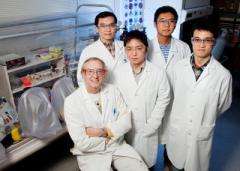Team develops new weapon to fight disease-causing bacteria, malaria

Researchers report that they have discovered - and now know how to exploit - an unusual chemical reaction mechanism that allows malaria parasites and many disease-causing bacteria to survive. The research team, from the University of Illinois, also has developed the first potent inhibitor of this chemical reaction.
The findings appear in the Proceedings of the National Academy of Sciences.
"There is an urgent need for new drugs to combat malaria and bacterial diseases such as tuberculosis that are becoming resistant to existing treatments," said chemistry professor Eric Oldfield, who led the study. "Millions of people have tuberculosis, for example, and some of the bacterial strains that cause TB are completely drug resistant," he said. The parasites that cause malaria also have become resistant to quinine, chloroquine and now, artemisinin, three common treatments for the disease.
The new study focuses on an essential chemical pathway that occurs in malaria parasites and in most bacteria but not in humans or other animals, making it an ideal drug target. Several teams of researchers have spent nearly a decade trying to understand an important player in this cascade of chemical reactions, an enzyme known as IspH. This enzyme promotes the synthesis of a class of compounds, called isoprenoids, which are essential to life.
"Isoprenoids are the largest class of compounds on the planet," Oldfield said. "There are over 60,000 of them. Cholesterol is an isoprenoid. The orange beta-carotene in carrots is an isoprenoid. And bacterial cell walls are made using isoprenoids."
IspH (rhymes with "lisp, H") is a reductase. It acts on a cellular compound, HMBPP, "reducing" it by adding two electrons and two protons to it in an early stage of isoprenoid biosynthesis. Understanding the structure and function of IspH, researchers hope, will allow them to find a way to block it and shut down production of isoprenoids in the disease-causing bugs.
Oldfield and his colleagues already had discovered the structure of IspH, which has a cube-like cluster of iron and sulfur atoms at its core. They determined that the core contained four iron and four sulfur atoms, a finding they published in the Journal of the American Chemical Society in 2008. (Other researchers later maintained that there were only three iron atoms in IspH, but recently amended their proposed structure to include four iron atoms.)
In the search for possible compounds that would inhibit IspH, Oldfield and his colleagues, including graduate student Weixue Wang, turned to a powerful technique, called electron paramagnetic resonance (EPR), which allows researchers to determine molecular structure.
"We thought we could use this EPR technique to see how inhibitors bind to IspH," Oldfield said. "But some of the early EPR spectra that Weixue got were really unusual."
To make sense of what he was seeing, Wang reviewed other studies and discovered that the unusual spectra closely resembled those seen with another enzyme, nitrogenase, which also has a metal-sulfur core and also acts as a reductase. His EPR spectra, along with data obtained using computational methods, convinced the researchers that during the chemical reaction, IspH and the compound that it reduces, HMBPP, form an intermediate that involves a highly unusual iron-carbon bond.
"People have been studying iron-sulfur clusters for 40 or 50 years," Wang said. "But they never discovered such interactions between iron and carbon in four-iron, four-sulphur proteins."
The researchers noted that a chemical compound, acetylene, blocks the activity of nitrogenase. They reasoned that this compound - or a similar one - might also inhibit IspH.
They made derivatives of acetylene and engineered a compound, which they call PPP, to test against IspH. Laboratory tests revealed that PPP is in fact a powerful inhibitor of IspH.
"It's one thousand times more potent than previous inhibitors," Oldfield said.
PPP has not yet been tested in cells, and much work remains to be done to develop anti-malarial or antibacterial drugs based on the new findings, Oldfield said.
"We're really at the initial, key stage, which is understanding structure and function and getting clues for inhibitors - drug leads," he said. "But there are a finite number of proteins unique to bacteria and malaria parasites that can be targeted for the development of new drugs. And everyone agrees that this enzyme, IspH, is a tremendous target."
"The Oldfield group has uncovered completely unexpected behavior for iron-sulfur clusters," said U. of I. chemistry professor Thomas B. Rauchfuss, who was not involved in the study. "We can expect that their discovery will lead to intense follow-up studies because the results have obvious implications for both biomedicine and organometallic catalysis. Iron-sulfur clusters are found in all forms of life, so when a new function is discovered, it is big news to a wide community."
Provided by University of Illinois at Urbana-Champaign
















